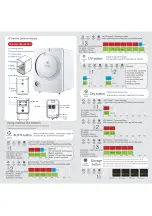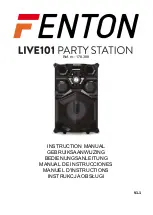
52
The TB to CR level affects both the cue speaker talkback level and
the talkback level going to the board operator headphones.
Cue
The Cue Level control adjusts the level of the cue speakers in the Meter
Bridge. It also adjusts the level of any external cue speakers. The control
does not affect the cue level feeding the board operator headphones. The
cue level is shown in the upper bar graph (labeled C) in the Studio Display.
Spare Buttons 1 - 4
Spare Buttons 1 – 4 have user-set functions so your engineering
department will have to identify what functions (if any) are assigned to
these buttons. Each button may be assigned to take a console event; to
take a salvo to setup the console for a specific show or application (like
voice tracking); or they can be set to control external devices, like a relay
to unlock the studio door or as a profanity delay dump button.
Studio
The volume of the studio monitor speakers can be controlled by the
Studio Monitors Level control, but often a studio-mounted level control
is used to adjust the levels in lieu of using this control. When a studio-
mounted control is used the Studio Monitors Level is set inactive (a
console configuration setting).
The Studio level is shown in the lower bar graph, with the speaker icon,
in the Studio Display (Figure 4-9 on page 51). The monitor speakers are
automatically muted, and a studio warning light triggered, whenever a
studio microphone is turned on. This muting is indicated by a red X over
the studio speaker icon.
STU TB
The board operator can talk to the studio monitor speakers using the
STU TB button located below the Studio Display. The level of talk into the
studio monitor speakers is controlled by the TB to STU level control in the
Meter column.
EXT TB
The board operator can talk to an external location like a call screener or
producer using the EXT TB button located below the Studio Display. Since
the EMX does not have a dedicated “external monitor” output, this button
is not defined from the factory. Engineering assigns this button’s functions
like the Spare 1 – 4 buttons. If there is no external location to talk to, this
button can be set for the same type of functions as the other four Spare
buttons.
Studio Display
This display (Figure 4-9 on page 51) shows the time above the white line
and the current studio monitor source below the white line. If the monitor
source name is green it indicates that it’s a source selected by a studio
monitor select button (that button is also lit). If the monitor name is red it
indicates an on-the-fly monitor source selected using the Studio Source
Selector or other method. No studio monitor select button is lit in this
case.
The studio monitor speakers are automatically muted, and a hot mic
warning light triggered, whenever a studio microphone is turned on. A red
X appears over the studio monitor speaker icon while a studio mic is on. If
cue is also sent to the studio then the C bar graph icon would also have a
red X.
Meter Column
The four Meter source selector buttons (EXT 1, EXT 2, TEL, and PGM 4)
select a source for the switched meter. PGM 4 is a dedicated source so
pressing it displays PGM 4 in the switched meter. The sources for the other
three buttons are assigned by engineering during console configuration.
Figure 4-10 Monitor Control Panel – Meter Display
An on-the-fly source can quickly be selected for the switched meter by
clicking the Meter Source Selector. The Meter Display (Figure 4-10)
changes to show the list of available sources. Rotate the source selector to
highlight the desired source name then click the selector to choose that
source. Its name is shown in red to indicate it’s a wild source. If a wild
source is assigned by a console event or salvo the switched meter source
name will also be red. In each case no meter select button will be lit.
TB to STU
The Talkback to Studio control adjusts the level of control room talk
going to the studio speakers. Its level is shown in the lower bar graph
(TBX) in the Meter Display. The talkback audio typically comes from the
board operator mic, but it can also be set for a host or a producer mic, or
be set to combine several mics so several people can talk into the studio.
Talkback is initiated by press/holding the STU TB button at the bottom of
the Studio column.
Timer
The meter bridge timer is manually controlled using three of the four
Timer Controls: RST (Reset timer); HLD (Hold timer display); and S/S
(Start/Stop timer). The fourth button, AUTO allows channel on commands
Summary of Contents for EMX
Page 4: ...4 ...












































